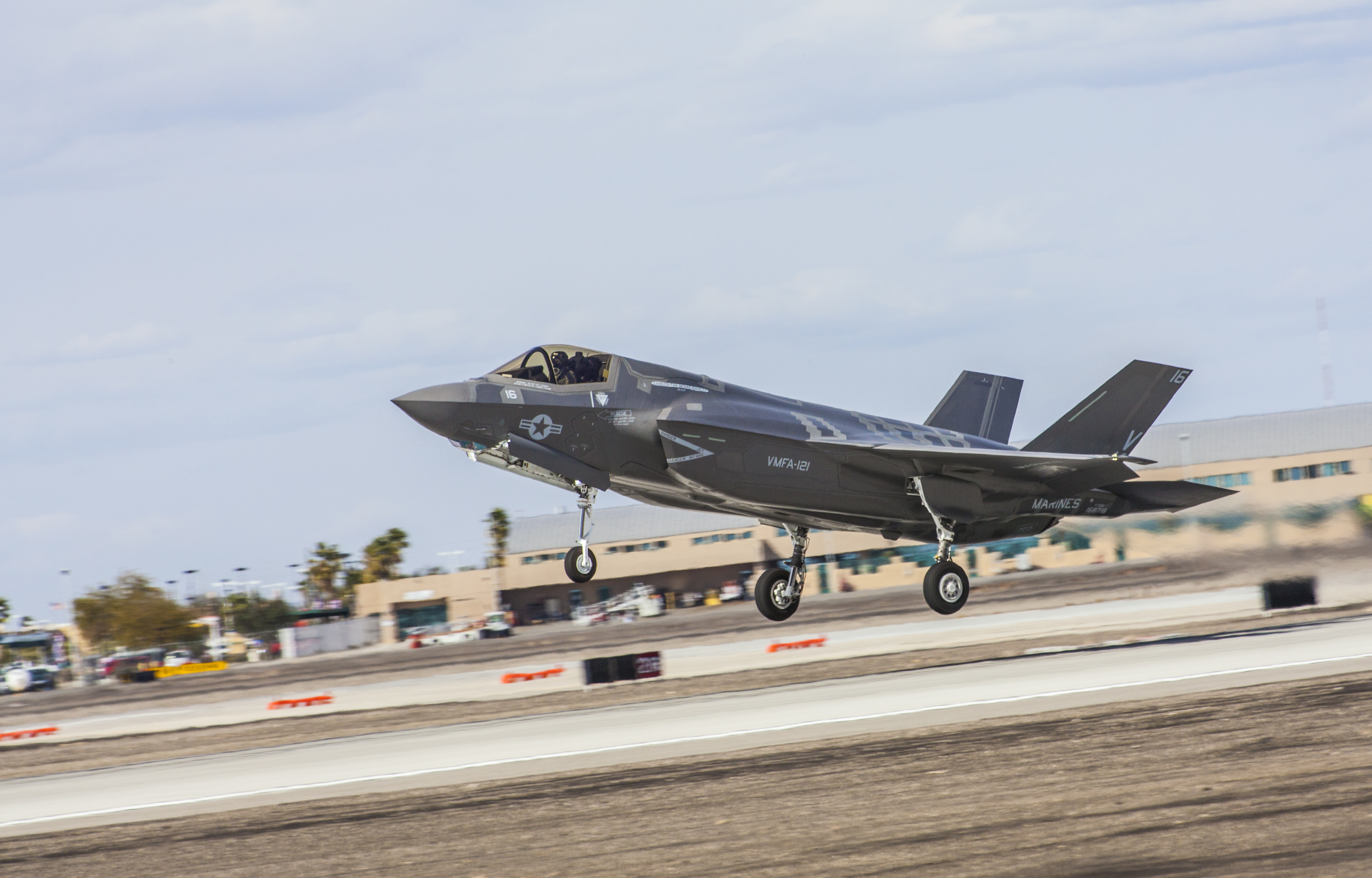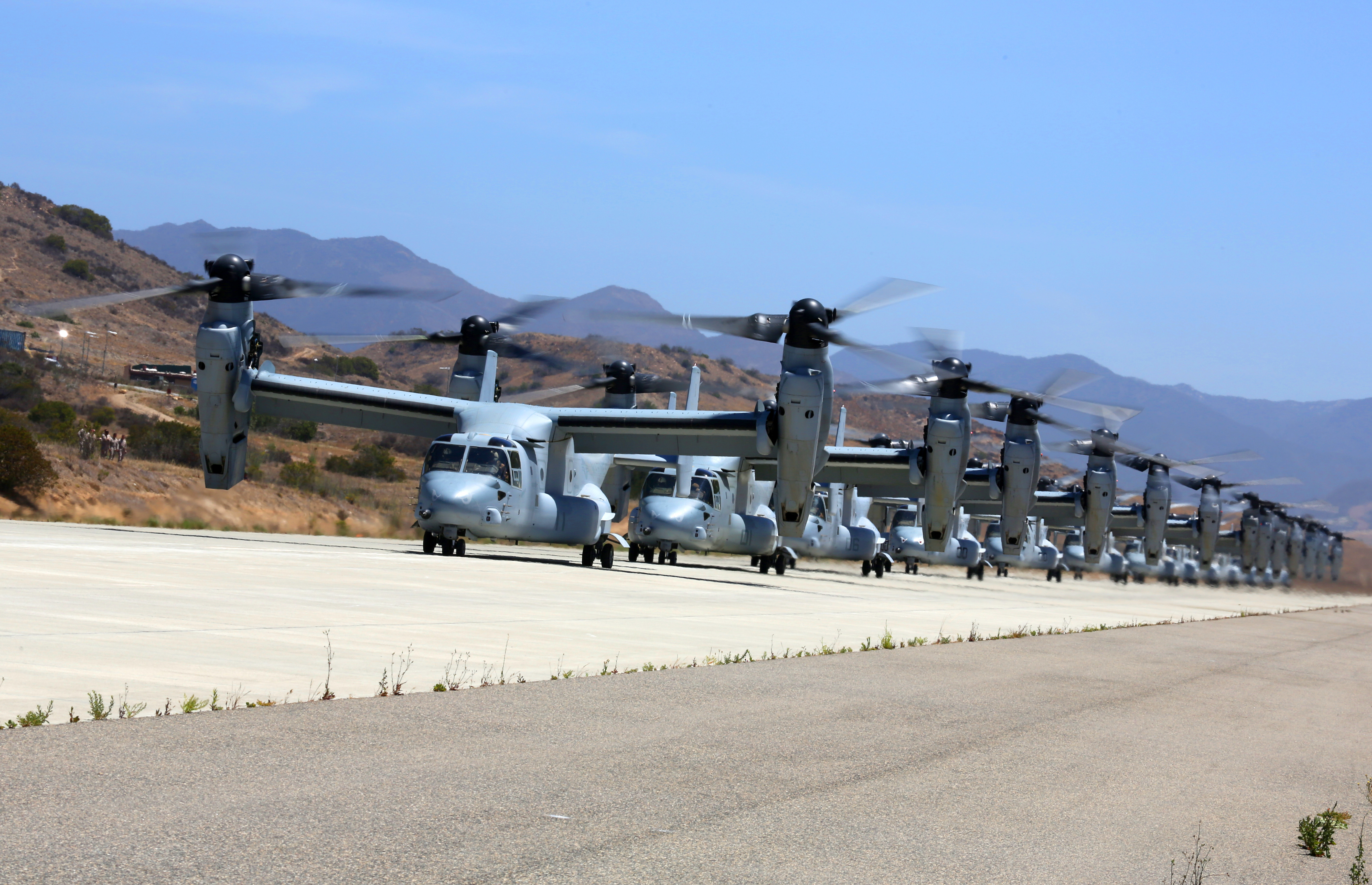
This article is part of a two-story package on the current state of Marine Corps aviation. Please read USMC Emphasizing Spare Parts, Maintainer Training To Regain Aviation Readiness: A Headquarters Perspective for the headquarters perspective.
The flight line at Yuma Marine Corps Air Station, Ariz., got busier on Monday when two operational F-35B Joint Strike Fighter jets arrived at their new West Coast home. The single-seat jets are the first to join Marine Attack Squadron 211, which has flown the AV-8B Harrier II jump jet as part of 3rd Marine Aircraft Wing (MAW).
Next month, the “Avengers” of VMA-211 will be redesignated as Marine Fighter Attack Squadron 211 (VMFA-211) and continue to grow with additional jets, marking a key milestone as the Marine Corps’ second operational squadron to transition to the F-35B Lightning II.
The desert base is a temporary home for the Corps’ first operational squadron of the next-generation jet. In January, VMFA-121, the first tactical unit to get the F-35B, will relocate from Yuma to Japan, Maj. Gen. Michael Rocco told an audience at Point Loma Naval Base in San Diego on Tuesday.
The squadron, nicknamed the “Green Knights,” will be forward-deployed to Iwakuni MCAS, where it will join 1st MAW and support 31st Marine Expeditionary Unit and III Marine Expeditionary Force.
The Marine Corps is working “hand in hand” with the Navy to prepare for the F-35B to deploy aboard ship with an amphibious ready group, or ARG, later next year. “The ships are being reconfigured for the JSF,” Rocco said. That includes modifying flight decks to handle the heat from the jet while it’s in the VTOL, or vertical takeoff and landing, mode, as well as incorporating various communications and electronic warfare suites.
“The first deployment on an ARG will be out in WestPac (Western Pacific) on the 31st MEU in the fall of ’17,” Rocco said.
“We’ll get the squadron out there, a 10-plane squadron, in January 2017. We’ll put six more aircraft out there in the summer of ’17 and then in the fall of ’17 is when the ship will be ready” to take on the jets.
Rocco, who commands 3rd Marine Aircraft Wing at Miramar MCAS in San Diego, said the F-35 presence in the western Pacific will bolster military capability in the region. The jet is equipped with advanced sensors and provides greater digital interoperability and improved lethality against air and ground targets than older legacy aircraft it will replace. Much of the jet’s capabilities are “so classified, you can’t even talk about it,” Rocco said during the monthly meeting of the San Diego Military Advisory Council, a non-profit group supporting the military and defense community in the region.
“It’s remarkable,” he said. “Most people are not aware of the capabilities of that aircraft. But trust me when I say it: That is a game-changing aircraft.”
The aircraft continues to undergo additional testing and software upgrades, however. The Marine Corps expects to transition its third operational squadron in 2018, with VMFA-122 trading its Hornets for F-35Bs and shifting to Yuma, according to the 2016 Marine Aviation Plan.
The Marine Corps is counting on the multi-role JSF to replace its aging fleets of Harrier attack jets and F/A-18 Hornet jets.
“We at Miramar are going to transition to the JSF a couple of years early,” he told the San Diego audience, with all local squadrons transitioning by 2019, or two or three years earlier than officials initially planned. With that, he noted, “there’s some stuff that needs to happen, like hangars and some big buildings for (military) construction” to support those units.
The Marine Corps, and particularly Marine aviation, is undergoing a major transformation as the service presses ahead to modernize and reset its war-wearied force. It’s doing that while grappling with significant maintenance and parts shortfalls, reduced readiness and continued operational demands.
The Miramar-based 3rd MAW has fully transitioned to the UH-1Y “Yankee” utility helicopter that replaced the Vietnam-era Hueys, Rocco said. It has “one more squadron” to fully transition its attack-utility helicopter fleet from the AH-1W to the AH-1Z Super Cobra, he said. “We’re going to introduce that aircraft to Okinawa pretty soon.”
As for the MV-22 Osprey, which the Marine Corps counts on for medium-lift missions, “we are still in the throes of transitioning the V-22 squadrons,” Rocco said, and the wing will get two additional squadrons.

“The V-22 is the most requested aircraft in all of DoD,” he said. “Those Marines that are in the V-22 world — both the pilots and the maintainers — stay extremely busy. If you are a V-22 pilot, a captain, you’re pretty much stuck in the squadron.”
“Their tempo is spending six months overseas or on a MEU or Special Purpose MAGTF, then back for about a year — MEU squadrons get a little more time, Special Purpose squadrons get a little less time. And then they go right back out.”
There’s a cost for that high operational tempo, however. “I’ll tell you who’s tired: The families are tired,” Rocco said. Marines “really don’t get to do much else but say goodbye to their families, and when they get back (home), they do it all over again.”
Another sought-out aircraft is the CH-53E Super Stallion, the Marine Corps’ heavy lifter. But the maintenance-demanding aircraft continues to suffer with degraded readiness and availability, concerns raised by officials in testimony to Congress.
“We can’t do our mission in the Marine Corps without the CH-53. It is the only heavy-lift platform that we have, and it is the last to transition,” Rocco said. Its replacement, the CH-53K, “is doing very well” but isn’t anticipated to arrive until 2019.
The Super Stallion, a “beast of an aircraft,” he said, “is old. It is tired.” Marines maintaining the aircraft “are working their backsides over to get that aircraft flying,” he added, noting “we don’t give (them) enough credit.”
Rocco, a veteran AH-1W Super Cobra pilot, commands a wing that includes about 100 aircraft and 16,000 Marines and sailors in five air groups. Wing Marines currently are supporting operations in Yemen, Iraq, Kuwait and southern Syria, as well as in Japan in Okinawa and Iwakuni, and with the 31st Marine Expeditionary Unit.
“It’s a busy wing,” Rocco said. “Do we have challenges? Absolutely. Do we have all the aircraft we need? No, we don’t. Do we have all the parts we need? No, we don’t,” he said. “But when we talk about execution, about ‘be ready’… 99.4 (percent of required flight hours executed) outstrips any other wing in the Marine Corps.”
Still, he said, shortages in parts lead to cannabalizing aircraft for parts and putting more hours on the available aircraft. That practice, though, comes at a price he likened to “eating our seed corn a little bit.”
“Because we’re running that aircraft longer than we ever thought, parts that we’d never anticipated breaking we are breaking,” he added. He’s seeing similar patterns with the CH-53E and MV-22. Shortages of parts lead to cannabalization that then requires at least twice the amount of work and time. “We can’t afford to wait for the parts. We can’t afford to wait for the aircraft,” he said. “We have to be ready. We are on a 1:2 dwell.”





